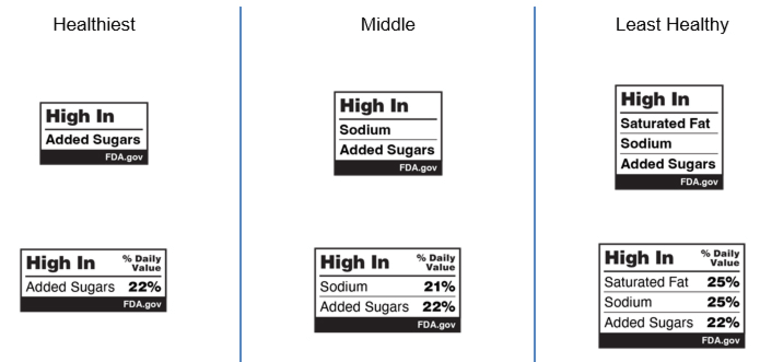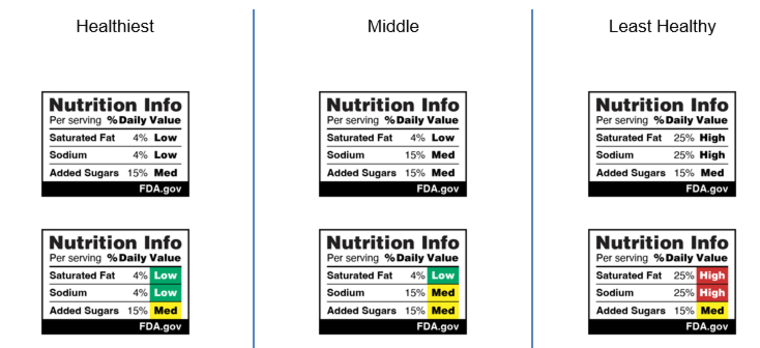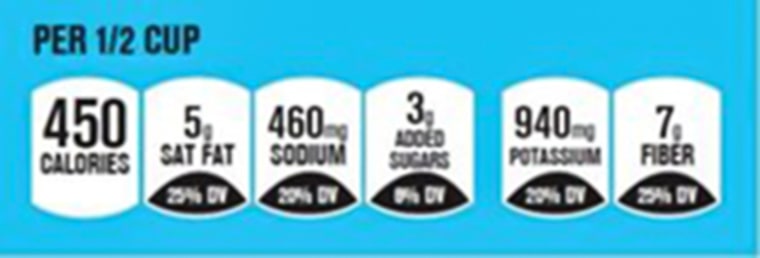The Food and Drug Administration is expected to propose a change to prepackaged food sold in America: a requirement that the front of the packages display key nutrient information in addition to the nutrition label that’s already on the back.
The concept, designed to quickly convey health ramifications to busy consumers about the food and beverages they are considering purchasing, is not novel: Worldwide, dozens of countries already have front-of-package nutrition labels that come in various designs. In Chile, for example, a stop sign symbol on the front of an item indicates if it has high sugar, saturated fat, sodium or calories. In Israel, there’s a red warning label on such food and drinks. And in Singapore, beverages display a letter grade based on how nutritious they are.
Advocates have been asking the FDA for nearly two decades to require front-of-pack labels, which they say help people make healthier choices and prod food manufacturers to reformulate their recipes so they have fewer warnings on their products. The FDA stayed largely silent on the issue until it announced intentions to explore front-of-pack labels as part of a national health strategy released during a landmark White House Conference on Hunger, Nutrition, and Health in 2022. Since then, it has reviewed literature on front-of-pack labeling and conducted focus groups to test designs for labels.
But the idea faces opposition from trade associations representing America’s food and beverage makers, who created their own voluntary system for highlighting certain nutrients on the front of packages over a decade ago. And some of the label designs being considered by the FDA could be challenged on First Amendment grounds.
“The U.S. does interpret free speech much broader and more inclusive of corporate speech than any other country in the world,” said Jennifer Pomeranz, an associate professor at the New York University School of Global Public Health who has researched First Amendment obstacles to mandating front-of-package food labels.
Designs that are purely factual — stating the number of grams of added sugars, for example — are more likely to be considered constitutional than interpretive designs that have shapes or colors that characterize a product as unhealthy, her research found.
“It starts to get more iffy when you go into subjective,” Pomeranz said.
Among the multiple label options tested by the FDA, some used traffic light colors to indicate whether there was a high (red), medium (yellow) or low (green) amount of saturated fat, sodium or added sugars; others stated if a product was “high in” those nutrients, sometimes adding the percentage of the recommended daily value that a serving size contains.

A spokesperson for the FDA declined to disclose to NBC News which label design it will use and did not say exactly when the agency will release its proposed rule, other than to say “it is targeting for this summer,” despite previously setting a deadline of this month.

The Consumer Brands Association and the food industry association FMI, which created a voluntary label system for the food and beverage industry called Facts up Front that launched in 2011, have made clear they are against mandatory interpretive designs such as a red light/green light system. Interpretive labels “will raise unnecessary fear in consumers based on a single limiter nutrient without providing meaningful information as to how that food item might fit into overall healthy eating patterns,” they wrote in a public comment to the FDA in 2022.
They also say their voluntary system addresses the needs of consumers. Facts up Front uses up to four icons on the front of packages to highlight calories, saturated fat, sodium and added sugars per serving size. Manufacturers can also include nutrition information for up to two “nutrients to encourage,” such as potassium or fiber. The Consumer Brands Association says hundreds of thousands of products carry Facts up Front: 207,000 foods and beverages displayed them as of 2021, according to the most recent data available from the group.

“It’s really giving consumers a quick, consistent and holistic look at what the nutrition composition is of whatever they’re purchasing, and then helping those consumers make informed decisions,” said Sarah Gallo, the association’s vice president of product policy.
Advocates for mandatory front-of-package labeling disagree, arguing that the Facts up Front campaign is not used enough: By contrast, the nutrition facts label that is federally mandated to be on the backs or sides of packages appears on billions of products.
“Front-of-pack labeling is only reliable for consumers if it appears across the entire food supply, not only on the products of a handful of manufacturers who opt into a voluntary program,” said Eva Greenthal, a senior policy scientist at the food and health advocacy group Center for Science in the Public Interest, which first petitioned the FDA in 2006 to implement front-of-pack labels.
She also said Facts up Front does not give enough context to be helpful.
“Facts up Front does not provide any additional tools to help the consumer interpret that information,” she said. “We need something like the word ‘high in.’”
Courtney Gaine, president and CEO for the Sugar Association, the trade association for the U.S. sugar industry, said her group supports transparency but questions whether mandatory front-of-pack labeling will improve Americans’ diets.
“It just doesn’t seem like this has the evidence to show that this will make a difference,” she said.
But Greenthal and other advocates say there’s data from around the world to support it. In Chile, which in 2016 became the first country to apply front-of-package nutrition information, studies show people have made healthier consumer purchases and are choosing from healthier product reformulations.
“I think it’s a very classic food industry, anti-regulatory tactic to deny the science supporting a new policy that might be difficult to implement but is beneficial for society,” Greenthal said.
In its own review of scientific literature on front-of-pack labels, the FDA concluded that the labels “can help consumers identify healthy foods” and “appear helpful for those with lower nutrition knowledge and busy shoppers.”
The discussion comes as the percentage of Americans who are considered overweight or obese has risen, with obesity affecting about 42% of U.S. adults. More than 1 million Americans die from diet-related diseases such as cardiovascular disease, diabetes and certain cancers annually, according to the FDA.
The statistics don’t mean that the nutrition facts box that became required on the backs or sides of food packaging three decades ago has been a failure, said Xaq Frohlich, an associate professor of history at Auburn University and the author of the book “From Label to Table: Regulating Food in America in the Information Age.”
“Every time there’s been a change in the label, the food industry has reformulated its foods,” he said. “So even if you’re not reading the label, the food is changing, and it’s having that kind of impact.”
Greenthal said there are many people who would benefit from more nutritional information on the front of packages: busy parents rushing through the supermarket, people with low levels of nutrition literacy, and anyone else with limited time and energy to invest in their food choices.
“Policies like front-of-package labeling couldn’t come any sooner,” she said. “Diet-related chronic disease is one of the most important problems facing our country and hindering our population’s health.”



